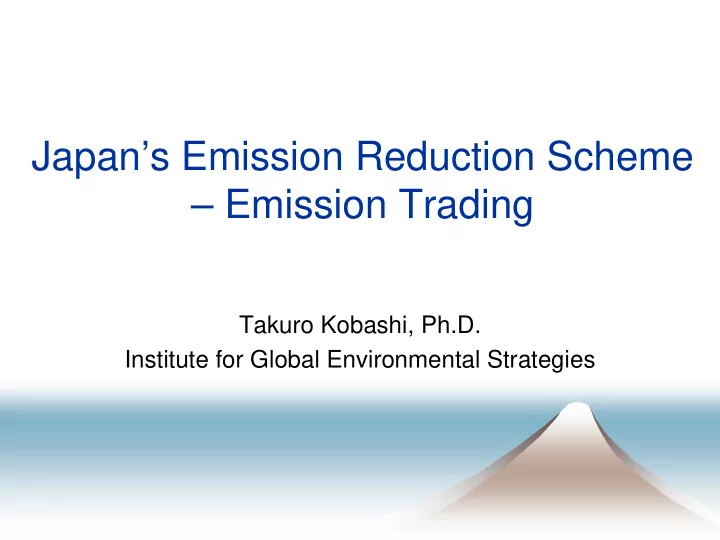

Japan’s Emission Reduction Scheme – Emission Trading Takuro Kobashi, Ph.D. Institute for Global Environmental Strategies
Outline � Kyoto Target and Plan � Carbon Markets in Japan � Trial Integrated Carbon Market
Kyoto Target and Plan
Kyoto Protocol Target Achievement Plan 1,361 1,355 1,358 (Million CO 2 tons) 1,340 +7.8% +7.6% +7.8% +6.3% Domestic reduction amount 国内排出量の削減 (民間事業者等による対応) - Achievement by 1,300 . . . private companies △ 6.5% and others - 1,261 - 6.9% Forest sinks 森林吸収源 - 3.8% △ 3.9% -6% 1,200 京都メカニズム Kyoto Mechanisms △ 1.6% - 1.6% 1,100 1990 2003 2004 2005 2006 (2008 – 2012) the first commitment period Base year
Trends in Emissions by Sectors 482 (mT) Industry (e.g., factories) 460 (mT) CO 2 (mT) Transport 254 (mT) 217 (mT) Business (e.g., services and offices) 229 (mT) 164 (mT) 166 (mT) Household 127 (mT) Energy (e.g., power plants) 77 (mT) 62 (mT)
Fukuda Vision � Announced on June 9 th . � A long term goal of 50% emission reduction by 2050. � Development and promotion of innovative technologies � Trial for Emission Trading
Actors for market mechanisms in Japan International Carbon Market (e.g., Prime Minister CDM) and Cabinet Tokyo A trial integrated market (Cap&Trade) (Cap&Trade) METI MoE •Voluntary •JVETS Action Plan •Carbon Offset •Internal Credit System •Option 4 (domestic CDM) Keidanren
Carbon Markets in Japan
Carbon Markets in Japan � JVETS (since 2005) � Internal Credit System (domestic CDM) � Carbon offsets � Clean Development Mechanism (CDM) � Tokyo metropolitan C&T
Basic Scheme Scheme Allocation Support Timing Phase Target Voluntary MOE Since 2005 1 year Emission JVETS C&T Amount Mandatory MOE From this TBA Intensity / Option4* (MoE) October Emission C&T Amount Credits and METI From this Until 2012 CO2 Internal Credit trading October Intensity System Tokyo Mandatory Tokyo From 2010 5 years Emission C&T Amount
JVETS � Voluntary emission trading scheme in Japan since 2005 by MOE. � Rapidly growing since the beginning of 2008 with over 200 participants (e.g., steal, paper & pulp, ceramics). � The “monitoring, reporting and verification system” under JVETS can be a basis for a mandatory C&T in the future.
JVETS – Term 2006 � 61 companies participated � 55k ton of CO2 emission amount was traded. � The average price was 1250 yen ($12)/ton. � Total CO 2 emission reduction was 280k ton.
Carbon Offsets in Japan � Carbon offset allows flexible emission reduction in Japan for individuals, events, etc. � Two types credits “Verified Emission Reductions (c-VERs, v-VERs)” have been considered in MOE. � c-VERs can be used for the trial market.
Internal Credit (CDM) System � Beginning from October � Domestic CDM system � Large cooperates help small-medium cooperate’s efforts for mitigation, and obtain credits for their reduction. � Similar to Clean Development Mechanisms but domestic version.
Tokyo’s Initiative � Mandatory cap & trade system beginning from FY2010 � Gas covered: CO2 � Cap setting: Base year emission × 5(years) × Compliance factor (e.g., 0.9) � Penalty: Financial penalty � Several local governments (e.g., Saitama, Ishikawa, Shimane) may join Tokyo
Trial Integrated Carbon Market
Trial Integrated Market � Beginning from October � Cap & Trade � Voluntary participation and target setting � No penalty � Allow use of various kinds of credits existing in Japan (e.g., CERs, jCERs, VERs)
The Trial Scheme Consideration by MoE � Mandate absolute emission caps � Use the mechanism of JVETS as a basis for the trial � Allow the use of additional reduction through forest biomass and small-medium enterprise efforts as credits
� Built upon “Keidanren Voluntary Action Plan”. � Amount of emissions = intensity × activity level
Consideration by METI � Based on Voluntary Action Plan (sector targets) � GHG emission or intensity unit � Voluntary target setting (GHG emission or intensity unit). � Credits: 1. CERs, 2. credits from “Internal Credit (CDM) System”, 3. credits generated from voluntary energy intensity targets, 4. credits from JVETS
Thank you for your attention! Takuro Kobashi (kobashi@iges.or.jp) Tel :+81-(0)46-855-3871 Institute for global Environmental Strategies
Recommend
More recommend